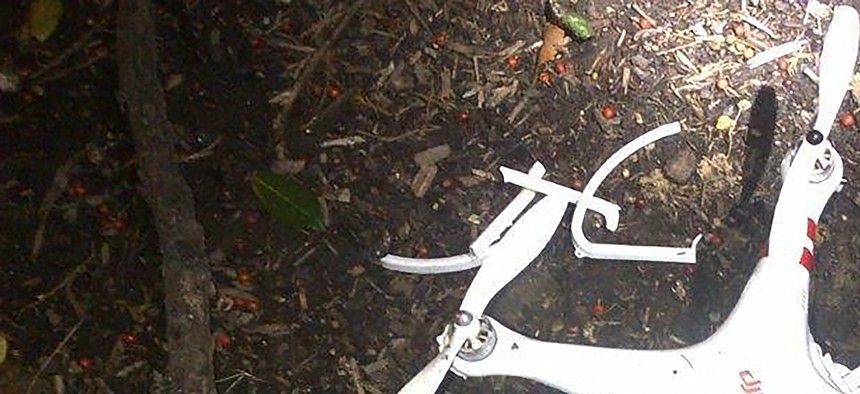
This handout photo provided by the US Secret Service shows the drone that crashed onto the White House grounds in Washington, Monday, Jan. 26, 2015 Secret Service
Did the White House Use Drone Killing Technology?
Here's how the White House can keep drones off its lawn but you can't off yours. By Patrick Tucker
This story has been updated.
At about 3 a.m. on Monday morning, a small quadcopter drone, or unmanned aerial vehicle, crashed on the White House lawn. White House officials said that the drone, by itself, was unarmed and didn’t represent a threat. Authorities quickly located the owner, a government employee, who has managed (so far at least) to convince the Secret Service that he made an innocent mistake flying his drone outside of the White House in the wee hours of the morning.
Update: The government employee reportedly works for the National Geospatial Intelligence Agency, an agency tasked with securing satellite and drone images for the military as well as other government bodies. The employee did not work with drones.
The White House won’t comment on whether or not they took any special steps to bring down the small UAV. But the White House may have employed the same anti-drone technology that the military is trying to perfect to protect ships and planes from future drone swarms. There are plenty of ways to knock a drone out of the sky, everything from surface to air missiles to hunter-killer robots to, yes, lasers . But for a cheap off-the-shelf drones operating off a simple radio or Wi-Fi signal, the best method is simple jamming.
For the military, signal jamming is an increasingly important component of electromagnetic warfare, or EW. It’s an area of growing concern as the electromagnetic spectrum, an area where the United States once enjoyed sole dominance, is becoming increasingly crowded.
(Related: Drone-Hunting Blimp Launches Over Washington )
What might the White House have used to jam the signal? Defense contractor Raytheon markets a wide variety of electronic anti-drone jammers. That includes the enormous “ next generation jammer” that comes in at $10 billion as well as some that actually fly, such as the miniature air-launched decoy (with jamming kit) or MALD-J .
But drone jamming doesn’t have to come in at billions of dollars. For instance, a device called the Cyborg Unplug promises to make your living area drone free for around $66.
Here’s how the manufactures describe it on their website . “Cyborg Unplug hits wireless surveillance devices where it hurts: network connectivity. 'Plug to unplug', it sniffs the air for wireless signatures from devices you don't want around, sending an alert to your phone when detected. Should the target device connect to a network you've chosen to defend, Cyborg Unplug will immediately disconnect them, stopping them from streaming video, audio and data to the Internet… Detected wireless devices currently include: wearable 'spy' cameras and microphones, Google Glass and Dropcam, small drones/copters and a variety of popular spy devices disguised as familiar objects.”
You can also make your own jammer with easily obtainable components, as researcher Ahmad Jisrawi points out.
There’s just one problem, cell phone, Wi-Fi and signal jamming in the United States is illegal. So use your home jammer at your own peril. If you just want to detect a drone and then down it via some more conventional means, outfits like Droneshield.org or Domestic Drone Counter Measures have all that you need, off mesh network components that can pick up and report a drone’s signal nearby.
Reports suggest that the drone seems to have crashed on its own, begging the question, is the White House equipped with an off-the-shelf drone jamming kit? If not, why not?
It’s an issue that won’t be going away. In fact, drones have been crashing all over Washington lately. On Jan. 21, a representative from 3D Robotics attended a hearing of the House Committee on Science, Space, and Technology and demonstrated how to pilot a small $500 Parrot Bebop UAV from his iPhone. The meeting broke history, marking the first time that an unmanned aircraft was flown— and crashed —inside a congressional hearing.
“Oh my gosh. And that’s your worst-case scenario! Drone crash. Drone crash!” Colin Guinn, 3D Robotics chief revenue office, said to committee members.
The other key takeaway from the event, the Federal Aviation Administration has no current strategy for integrating UAVs into commercial airspace, even though they are required to do it by Sept. 15 of this year, according to Section 333 of the FAA Modernization and Reform Act of 2012. What does that mean? Drones will be regulated by the current regime and, as demonstrated Monday, poorly policed even around targets of national security interest.
What’s the current FAA strategy regarding drones? If you want to fly a robot plane beyond your line of site, or one over 55 pounds or for any sort of commercial purpose at all, you need a special exemption from the FAA, of which they have granted 16 out of some 295 requests. The FAA prohibits flying within 5 miles of an airport.
James Williams, the manager for the FAA’s Unmanned Aerial Systems Integration Office told the House committee: “We’re in the process of building a tracking system…similar to laser systems…On the research side…we’ve started an initiative to assess the risk of an unmanned aircraft to a manned aircraft.” Williams added: “We’re accelerating that thanks to congressional funding this year.”
Monday’s event may accelerate that research further.




